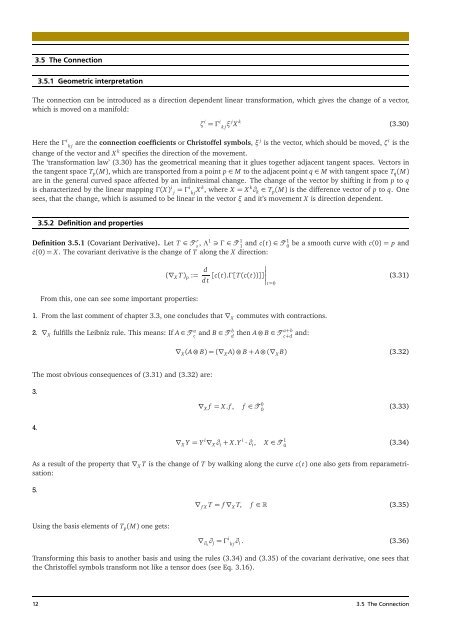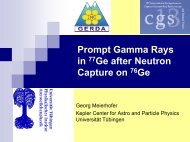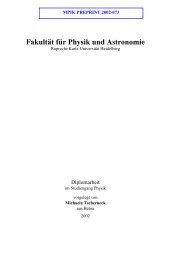Master Thesis
Master Thesis
Master Thesis
Create successful ePaper yourself
Turn your PDF publications into a flip-book with our unique Google optimized e-Paper software.
3.5 The Connection<br />
3.5.1 Geometric interpretation<br />
The connection can be introduced as a direction dependent linear transformation, which gives the change of a vector,<br />
which is moved on a manifold:<br />
ζ i =Γ i<br />
k j ξj X k<br />
(3.30)<br />
Here theΓ i<br />
k j are the connection coefficients or Christoffel symbols,ξj is the vector, which should be moved,ζ i is the<br />
change of the vector and X k specifies the direction of the movement.<br />
The ‘transformation law’ (3.30) has the geometrical meaning that it glues together adjacent tangent spaces. Vectors in<br />
the tangent space Tp(M), which are transported from a point p∈M to the adjacent point q∈ M with tangent space Tq(M) are in the general curved space affected by an infinitesimal change. The change of the vector by shifting it from p to q<br />
is characterized by the linear mappingΓ(X) i<br />
j =Γi k jX k , where X= X k∂k∈T p(M) is the difference vector of p to q. One<br />
sees, that the change, which is assumed to be linear in the vectorξand it’s movement X is direction dependent.<br />
3.5.2 Definition andproperties<br />
Definition 3.5.1 (Covariant Derivative). Let T∈� r<br />
s ,Λ1 ∋Γ∈� 1<br />
1<br />
˙c(0)=X. The covariant derivative is the change of T along the X direction:<br />
From this, one can see some important properties:<br />
(∇X T) p := d<br />
d t [c(t).Γ[T(c(t))]]<br />
�<br />
�<br />
�<br />
1. From the last comment of chapter 3.3, one concludes that∇ X commutes with contractions.<br />
2.∇ X fulfills the Leibniz rule. This means: If A∈� a<br />
b<br />
a+b<br />
c and B∈� then A⊗ B∈� d c+d and:<br />
The most obvious consequences of (3.31) and (3.32) are:<br />
3.<br />
4.<br />
and c(t)∈�1 0 be a smooth curve with c(0)= p and<br />
� t=0<br />
(3.31)<br />
∇ X(A⊗ B)=(∇ X A)⊗ B+ A⊗(∇ X B) (3.32)<br />
∇ X f = X .f , f∈� 0<br />
0<br />
∇ X Y= Y i ∇ X∂ i+ X .Y i ·∂ i, X∈� 1<br />
0<br />
(3.33)<br />
(3.34)<br />
As a result of the property that∇ X T is the change of T by walking along the curve c(t) one also gets from reparametrisation:<br />
5.<br />
Using the basis elements of T p(M) one gets:<br />
∇ f X T=f∇ X T, f∈� (3.35)<br />
∇ ∂k ∂ j=Γ i<br />
k j ∂ i . (3.36)<br />
Transforming this basis to another basis and using the rules (3.34) and (3.35) of the covariant derivative, one sees that<br />
the Christoffel symbols transform not like a tensor does (see Eq. 3.16).<br />
12 3.5 The Connection
















